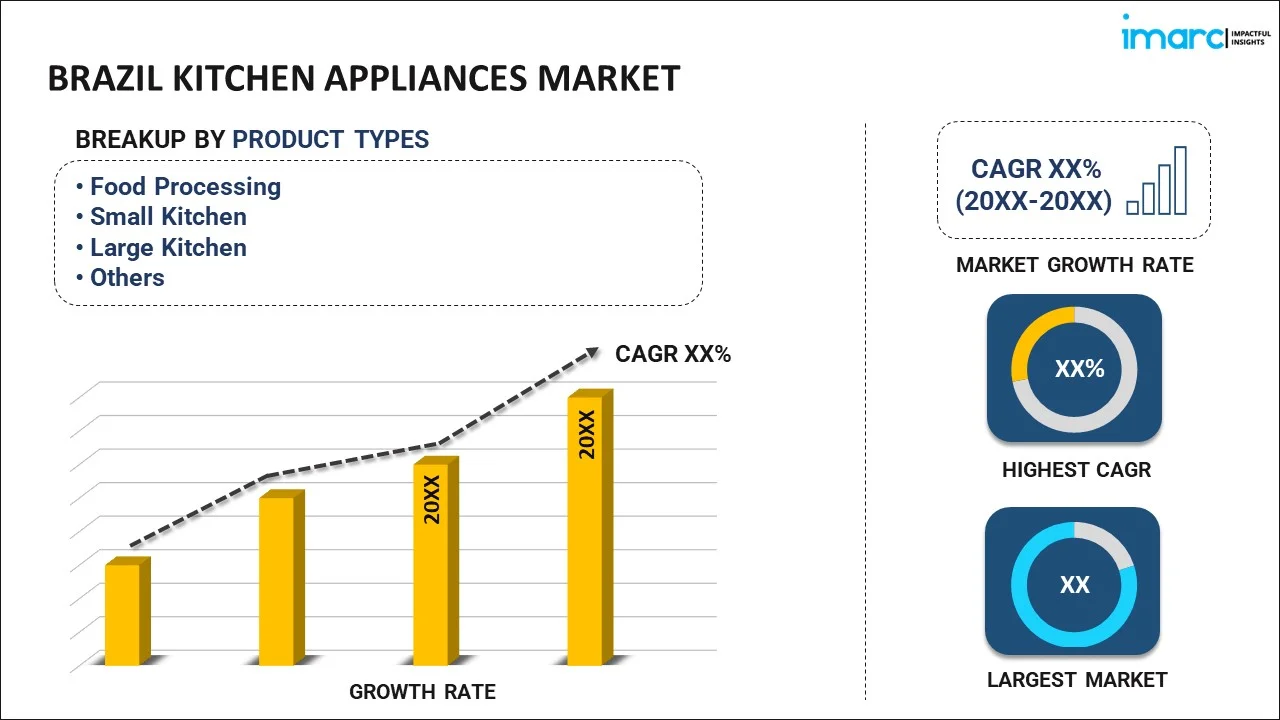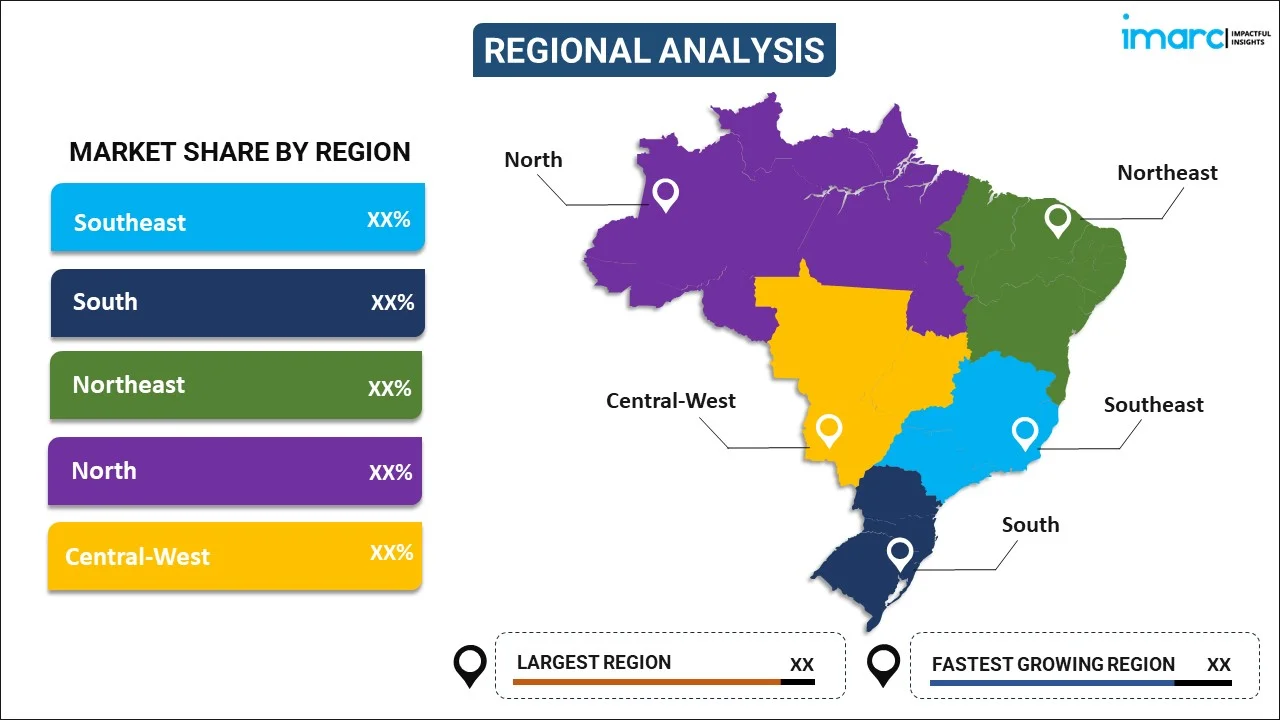
Brazil Kitchen Appliances Market Report by Product Type (Food Processing, Small Kitchen, Large Kitchen, and Others), Distribution Channel (Offline, Online), and Region 2024-2032
Market Overview:
Brazil kitchen appliances market size is projected to exhibit a growth rate (CAGR) of 4.68% during 2024-2032. The rising disposable incomes, increasing urbanization, rapid proliferation of e-commerce, technological advancements and integration of kitchen appliances with smartphones and voice-controlled devices, and increasing consumer preferences for energy-efficient household products represent some of the key factors driving the market.
|
Report Attribute
|
Key Statistics
|
|---|---|
|
Base Year
|
2023 |
|
Forecast Years
|
2024-2032 |
|
Historical Years
|
2018-2023
|
| Market Growth Rate (2024-2032) | 4.68% |
Kitchen appliances are electrical or mechanical machines that facilitate various cooking and food preparation tasks within a kitchen environment. These appliances range from large fixtures such as refrigerators, ovens, and dishwashers to smaller gadgets like blenders, toasters, and coffee makers. They aid in enhancing efficiency, conserving energy, and offering convenience, revolutionizing modern kitchens. Designed for specific purposes like heating, blending, and grilling, these appliances are now incorporating smart features like touch control, voice command, and connectivity to mobile applications, adding a layer of digital intelligence to physical cooking spaces. Since modern kitchen appliances are simplifying daily chores, reducing the time spent in the kitchen, and even offering health benefits through features like air frying and steaming, they are gaining immense popularity across Brazil.
Brazil Kitchen Appliances Market Trends:
In Brazil, the expanding middle-class population, coupled with inflating consumer disposable incomes, represents the primary factor driving the market growth. As financial stability within households improves, the willingness of individuals to invest in higher-end, more durable, and technologically advanced kitchen appliances naturally escalates. Additionally, rapid urbanization is leading to a surge in the construction of residential units across the country, which in turn is fueling the demand for advanced kitchen appliances. This is particularly evident in larger cities like São Paulo and Rio de Janeiro, where modern lifestyles necessitate the use of convenient and efficient appliances. Moreover, the rising consumer awareness regarding energy efficiency is positively influencing market growth. Brazil has set forth stringent energy efficiency standards, pushing manufacturers to produce appliances that consume less electricity. This shift addresses global environmental concerns and reduces long-term operational costs for consumers, making energy-efficient products increasingly attractive. Besides this, the market is also benefitting from the advent of smart technology. The integration of kitchen appliances with smartphones and voice-controlled devices is also gaining traction, especially among tech-savvy consumers seeking to manage their home appliances remotely. The recent coronavirus (COVID-19) pandemic has further accelerated this trend, as more people spend time at home and focus on home improvement, including kitchen upgrades. Furthermore, favorable government policies, such as reduced import duties on certain categories of appliances and easy credit schemes, are supporting market growth. In line with this, the availability of various financing options makes it easier for consumers to purchase appliances, allowing them to opt for more premium products, thus propelling market growth. Apart from this, the rapid proliferation of e-commerce is providing consumers with a wide variety of choices at competitive prices, thereby fostering market growth.
Brazil Kitchen Appliances Market Segmentation:
IMARC Group provides an analysis of the key trends in each segment of the market, along with forecasts at the country level for 2024-2032. Our report has categorized the market based on product type and distribution channel.
Product Type Insights:

- Food Processing
- Small Kitchen
- Large Kitchen
- Others
The report has provided a detailed breakup and analysis of the market based on the product type. This includes food processing, small kitchen, large kitchen, and others.
Distribution Channel Insights:
- Offline
- Online
A detailed breakup and analysis of the market based on the distribution channel have also been provided in the report. This includes offline and online.
Regional Insights:

- Southeast
- South
- Northeast
- North
- Central-West
The report has also provided a comprehensive analysis of all the major regional markets, which include Southeast, South, Northeast, North, and Central-West.
Competitive Landscape:
The market research report has also provided a comprehensive analysis of the competitive landscape in the market. Competitive analysis such as market structure, key player positioning, top winning strategies, competitive dashboard, and company evaluation quadrant has been covered in the report. Also, detailed profiles of all major companies have been provided.
Brazil Kitchen Appliances Market Report Coverage:
| Report Features | Details |
|---|---|
| Base Year of the Analysis | 2023 |
| Historical Period | 2018-2023 |
| Forecast Period | 2024-2032 |
| Units | US$ Million |
| Scope of the Report | Exploration of Historical Trends and Market Outlook, Industry Catalysts and Challenges, Segment-Wise Historical and Future Market Assessment:
|
| Product Types Covered | Food Processing, Small Kitchen, Large Kitchen, Others |
| Distribution Channels Covered | Offline, Online |
| Regions Covered | Southeast, South, Northeast, North, Central-West |
| Customization Scope | 10% Free Customization |
| Report Price and Purchase Option | Single User License: US$ 3699 Five User License: US$ 4699 Corporate License: US$ 5699 |
| Post-Sale Analyst Support | 10-12 Weeks |
| Delivery Format | PDF and Excel through Email (We can also provide the editable version of the report in PPT/Word format on special request) |
Key Questions Answered in This Report:
- How has the Brazil kitchen appliances market performed so far and how will it perform in the coming years?
- What has been the impact of COVID-19 on the Brazil kitchen appliances market?
- What is the breakup of the Brazil kitchen appliances market on the basis of product type?
- What is the breakup of the Brazil kitchen appliances market on the basis of distribution channel?
- What are the various stages in the value chain of the Brazil kitchen appliances market?
- What are the key driving factors and challenges in the Brazil kitchen appliances?
- What is the structure of the Brazil kitchen appliances market and who are the key players?
- What is the degree of competition in the Brazil kitchen appliances market?
Key Benefits for Stakeholders:
- IMARC’s industry report offers a comprehensive quantitative analysis of various market segments, historical and current market trends, market forecasts, and dynamics of the Brazil kitchen appliances market from 2018-2032.
- The research report provides the latest information on the market drivers, challenges, and opportunities in the Brazil kitchen appliances market.
- Porter's five forces analysis assist stakeholders in assessing the impact of new entrants, competitive rivalry, supplier power, buyer power, and the threat of substitution. It helps stakeholders to analyze the level of competition within the Brazil kitchen appliances industry and its attractiveness.
- Competitive landscape allows stakeholders to understand their competitive environment and provides an insight into the current positions of key players in the market.
Need more help?
- Speak to our experienced analysts for insights on the current market scenarios.
- Include additional segments and countries to customize the report as per your requirement.
- Gain an unparalleled competitive advantage in your domain by understanding how to utilize the report and positively impacting your operations and revenue.
- For further assistance, please connect with our analysts.
 Inquire Before Buying
Inquire Before Buying
 Speak to an Analyst
Speak to an Analyst
 Request Brochure
Request Brochure
 Request Customization
Request Customization




.webp)




.webp)












